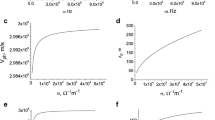Abstract
IT has recently been pointed out1 that though the charge leaving the cloud in a lightning flash to earth is probably about half as great again as had hitherto been believed, the potential of the thundercloud base is probably only a few per cent of previous estimates2. It already appears1 that the condition for the occurrence of a flash is not that the breakdown potential be attained over the whole intervening space2,3, but that a concentration of field should occur of sufficient intensity to initiate what may be called a ‘self-propagating’ discharge in a field which elsewhere may only reach a few hundred volts per cm. The implications of this are so important in the theory of discharges in general that further confirmation is very desirable. The purpose of this note is to suggest a mechanism to account for the ‘darts’ of the first leader stroke and the low overall voltage, to direct attention to a characteristic of such discharges which has hitherto been overlooked, and to suggest the condition under which spark breakdown occurs.
This is a preview of subscription content, access via your institution
Access options
Subscribe to this journal
Receive 51 print issues and online access
$199.00 per year
only $3.90 per issue
Buy this article
- Purchase on Springer Link
- Instant access to full article PDF
Prices may be subject to local taxes which are calculated during checkout
Similar content being viewed by others
References
Bruce, C. E. R., and Golde, R. H., J. Inst. Elect. Eng. (in press).
Wilson, C. T. R., Phil. Trans. Roy. Soc., 221, 73 (1921).
Meek, J. M., Phys. Rev., 55, 972 (May 15, 1939).
Schonland, B. F. J., Malan, D. J., and Collens, H., Proc. Roy. Soc., A, 152, 595 (1935).
Todd, F. C., and Browne, T. E., Phys. Rev., 36, 732 (Aug. 15, 1930).
Fan, H. Y., Phys. Rev., 55, 769 (April 15, 1939).
Attwood, S. S., Dow, W. G., and Krausnick, W., Trans. Amer. Inst. Elect. Eng., 50 (3), 854 (Sept., 1931).
Allibone, T. E., and Meek, J. M., Proc. Roy. Soc., A, 166, 97 (1939).
Author information
Authors and Affiliations
Rights and permissions
About this article
Cite this article
BRUCE, C. The Lightning and Spark Discharges. Nature 147, 805–806 (1941). https://doi.org/10.1038/147805b0
Issue Date:
DOI: https://doi.org/10.1038/147805b0
This article is cited by
-
Growth of Positive Channels in Non-uniform Fields during Impulse Breakdown
Nature (1963)
-
An important characteristic of long electrical discharges
Applied Scientific Research, Section B (1956)
-
Transition from Glow to Arc Discharge
Nature (1948)
-
Propagation of Lightning Leader Strokes
Nature (1941)
-
Wave form of Atmospherics
Nature (1941)
Comments
By submitting a comment you agree to abide by our Terms and Community Guidelines. If you find something abusive or that does not comply with our terms or guidelines please flag it as inappropriate.



